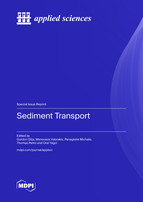Sediment Transport
A special issue of Applied Sciences (ISSN 2076-3417). This special issue belongs to the section "Earth Sciences".
Deadline for manuscript submissions: closed (20 August 2023) | Viewed by 23071
Special Issue Editors
Interests: sediment transport; bridge scour; dune morphodynamics; flood hazard; fishway hydraulics
Special Issues, Collections and Topics in MDPI journals
Interests: sediment transport dynamics; monitoring environmental flows; geomorphic processes and instrumentation
Special Issues, Collections and Topics in MDPI journals
Interests: scour sensing; bridge monitoring; early warning; critical infrastructure; intelligent structures; structural health monitoring; climatic risks; geo-hazards; dam assessment; risk ecosystems; natural hazards
Special Issues, Collections and Topics in MDPI journals
Interests: sediment transport driven by liquids and terrestrial and extraterrestrial atmospheric winds; sediment-transport-driven bedform formation and evolution; dry and wet granular flows; landslides
Interests: flow-vegetation-sediment interaction; coherent flow structures; eco-geomorphological processes; experimental hydraulics; river restoration; scour around bodies
Special Issue Information
Dear Colleagues,
Understanding the morphodynamic behavior of riverbeds is one of the most fundamental problems in fluvial geomorphology, especially in rivers suffering from extensive hydromorphological pressures. Sediment transport patterns present a continuous research challenge because of their impact on hydraulic structures, infrastructure, waterways, confluences or naturally morphologically variable zones like confluences and deltas. The significance of the physical alterations of rivers—natural or anthropogenic—is correlated with the increasing frequency, intensity and duration of natural hazards driven by climate change. The sustainable management of rivers and risk management related to them are based on the predictive tools emerging from the state-of-the-art research conducted under relevant environment-protection scenarios. Continuous advancements in the development of laboratory instruments, remote sensing techniques, numerical modelling of turbulent flows and data processing methods improve the understanding of the fluid–structure interaction underlying the sediment transport process. Such processes can vary across a wide range of scales, from the particle to the landscape, which can directly impact both the form (geomorphology) and function (ecology and biology) of natural systems and the built infrastructure surrounding them.
This Special Issue aims to publish recent advancements in sediment transport research and hydraulic engineering that contribute to filling the knowledge gap in morphodynamic processes at different scales, with an outlook towards innovative river engineering approaches, monitoring systems, available technologies, and management practices tackling rapidly changing environmental conditions. Contributions to this Special Issue can include, for example, particle-scale interactions and transport processes (sediment entrainment, momentum and energy transfer between turbulent flows and particles, interaction among grain sizes in poorly sorted mixtures, etc.), reach-scale sediment transport and geomorphic processes (bedform dynamics, derivation and solution of equations for multiphase flows, shallow water hydro-sediment-morphodynamic processes, scouring, etc.) and large-scale, highly unsteady and complex water-sediment flows (flash floods, flood defenses deterioration, dam incidents and compound disasters, reservoir operation schemes, dredging , maintenance and regulation for large rivers and navigational waterways, etc.).
As Guest Editors, we invite research articles, state-of-the-art reviews, applied research works, case studies and any corresponding concepts that contribute to the development of the field. The contributions for this Special Issue can include laboratory and field experimental studies, mathematical theories, the development of numerical or experimental methodologies, frameworks for the development of monitoring instruments and guidelines, numerical studies of coupled water–sediment flow, and practical case studies at various spatial and time scales. These contributions may include analyses of the sediment transport as a process (incipient motion conditions, turbulence and velocity pattern, development of empirical equations for sediment yield, bed sorting and armoring, dune migration, etc.), as well as its interaction with river structures (scour, sand bar formation, morphological development, bank undercutting, reservoir sedimentation, etc.).
Dr. Gordon Gilja
Dr. Manousos Valyrakis
Dr. Panagiotis Michalis
Dr. Thomas Pahtz
Prof. Dr. Oral Yagci
Guest Editors
Manuscript Submission Information
Manuscripts should be submitted online at www.mdpi.com by registering and logging in to this website. Once you are registered, click here to go to the submission form. Manuscripts can be submitted until the deadline. All submissions that pass pre-check are peer-reviewed. Accepted papers will be published continuously in the journal (as soon as accepted) and will be listed together on the special issue website. Research articles, review articles as well as short communications are invited. For planned papers, a title and short abstract (about 100 words) can be sent to the Editorial Office for announcement on this website.
Submitted manuscripts should not have been published previously, nor be under consideration for publication elsewhere (except conference proceedings papers). All manuscripts are thoroughly refereed through a single-blind peer-review process. A guide for authors and other relevant information for submission of manuscripts is available on the Instructions for Authors page. Applied Sciences is an international peer-reviewed open access semimonthly journal published by MDPI.
Please visit the Instructions for Authors page before submitting a manuscript. The Article Processing Charge (APC) for publication in this open access journal is 2400 CHF (Swiss Francs). Submitted papers should be well formatted and use good English. Authors may use MDPI's English editing service prior to publication or during author revisions.
Keywords
- bed and bank erosion
- diversions
- confluences
- dam/embankment assessment
- early warning systems
- experimental investigation
- field measurements
- flow–vegetation–sediment interactions
- fluvial hydraulics
- geo-hazards
- hydraulic structures
- hydrodynamics
- incipient motion
- monitoring systems
- morphodynamics
- numerical modeling
- reservoir sedimentation
- remote sensing
- river bed geomorphology
- scour
- scour control structures
- sediment transport
- waterways
Related Special Issues
- Sustainable Agriculture and Advances of Remote Sensing in Applied Sciences (33 articles)
- Geomorphology in the Digital Era in Applied Sciences (16 articles)










